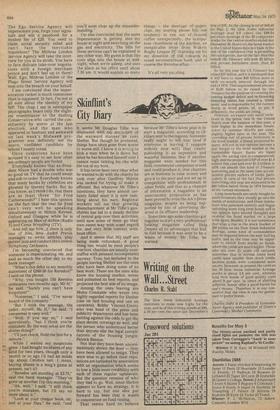Writing on the Wall. ..Street
Charles R. Stahl
The Dow Jones Industrial Average continues to make new highs for the year, and as of this writing stands at 848, a 50 per cent rise since last December's low of 570. At the closing level of 848.48 on May 2, the Dow Jones Industrial Average was 8.6 times the $99.04 per-share earnings of the 30 component stocks for the twelve months ended last December 30. However, the bond market in the United States does not bask in the sun of the confidence that is propelling the stock prices, due to the fact that this month the Treasury will seek $5 billion and private borrowers more than $2 billion.
So far this year the US Treasury has raised $25 billion, and it is estimated that it will have to raise $40 billion more at each six-month interval through the end of 1976. This unprecedented amount of $120 billion to be raised by the Treasury for the purpose of covering the coming budget deficit and re-financing. maturing issues has created a 'credit panic' and is responsible for the current slump in bond prices, or, to put it differently, the yields are rising. However, we expect only small variations in the prime rate in the United States over the balance of this year, a little higher in the immediate future, lower by summer (61/2-63/4 per cent), slightly higher later in the year. The 'crowding out' of private borrowers in the bond market, a theme promoted by many, will not in our opinion become a real danger to the bond market in the foreseeable future. Banks are liquid again, the saving rate is comparatively high, and the projected GNP of over $1.4 trillion this year and over $1.5 trillion in 1976 can absorb this kind of Treasury borrowing and at the same time accommodate private seekers of funds, particularly in view of the fact that private borrowings this year are estimated to be $80 billion below those in 1974 because of the current recession.
Long-term bonds are rarely bought by small investors; they usually go into the hands of institutions, and those institutions who panicked recently and began unloading some long term bonds will in our opinion have second thoughts and re-enter the bond market on a, large scale again. Besides, it is our contention that after a rise in the stock market of 280 points on the Dow Jones Industrial Average, some kind of consolidation may be required before the next bull leg starts, and so the time may be opportune to switch from stocks to bonds, where the yields are much higher. Those who are over 21 years old certainly remember that in normal times bond yields were smaller than stock yields, because bonds were considered more secure. However, at present the yield on the 30 Dow Jones Industrial Average stocks is about 3.9 per cent, whereas long term bonds of good quality yield about 9 per cent. In times of abetting inflation, bonds offer a good haven for one's money. Therefore it is our contention that the time is ripe for gentlemen to prefer bonds.
Charles Stahl is President of Economic News Agency and publisher of Green's Commodity Market Comments


























 Previous page
Previous page